We are exposed to thousands of advertising messages every single day. These messages take the form of digital ads, billboards, TV ads, and a lot more.
All of these marketing and advertising messages can be boiled down to two types of marketing: inbound and outbound.
But, what’s the difference between the two? Which is more effective? And how do you use them?
In this article, we’ll explore inbound marketing vs outbound marketing. You’ll learn the differences between the two, strategies you can use to get the most from your efforts, and how to use them together for the best results.
Let’s get started.
What Is Inbound Marketing?
Inbound marketing is the use of marketing tactics that bring consumers into you, rather than pushing your advertising messages out to them. It includes marketing tactics like content marketing, social media, nurturing leads, and blogging, among others.
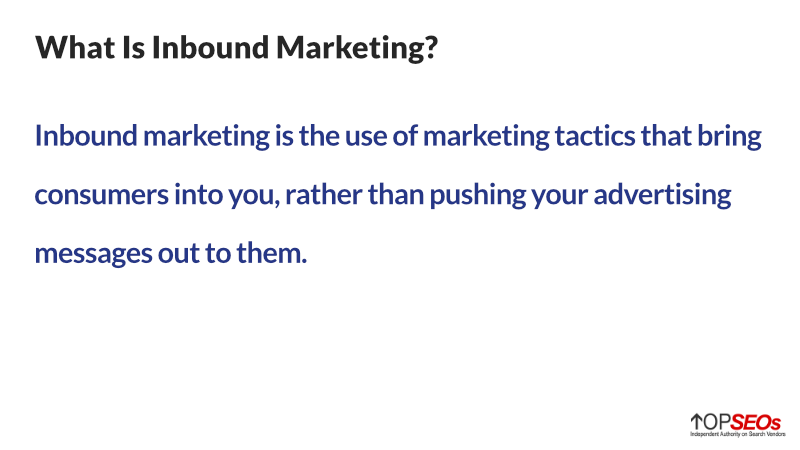
Inbound marketing, sometimes called “permission marketing,” means letting consumers find you and engage with you on their terms.
But how do you bring them to you?
Research them, learn what they want. Then, provide that. Inbound marketing is about providing value to your target audience and building a relationship with them, rather than telling them to buy something.
This will look different depending on where each member of your target audience is in your buying process.
What Is Outbound Marketing?
Outbound marketing is the use of marketing tactics that push your message out to consumers. This includes things like direct mail, mass email marketing, banner advertising, telemarketing, and more.
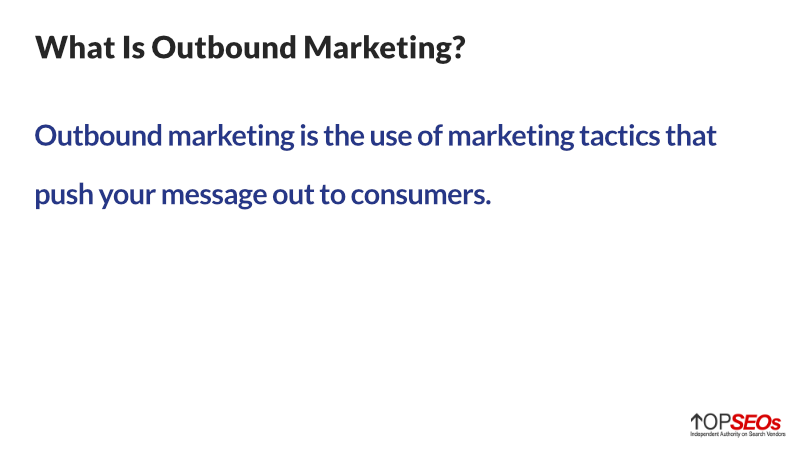
Outbound marketing is sometimes called “interruption marketing,” because its intent is to forcibly redirect attention from what your target audience is doing to your product or service.
Where inbound marketing lets the consumer direct the conversation, outbound marketing is all up to the marketer. You are in charge of what you want to say, when you’re going to say it, and where.
Outbound marketing tactics are still valuable to marketers, to be sure, but they’re being used less and becoming less effective because consumers want control.
Consumers want to do their own research and engage with marketing messages on their terms.
Inbound Marketing vs Outbound Marketing
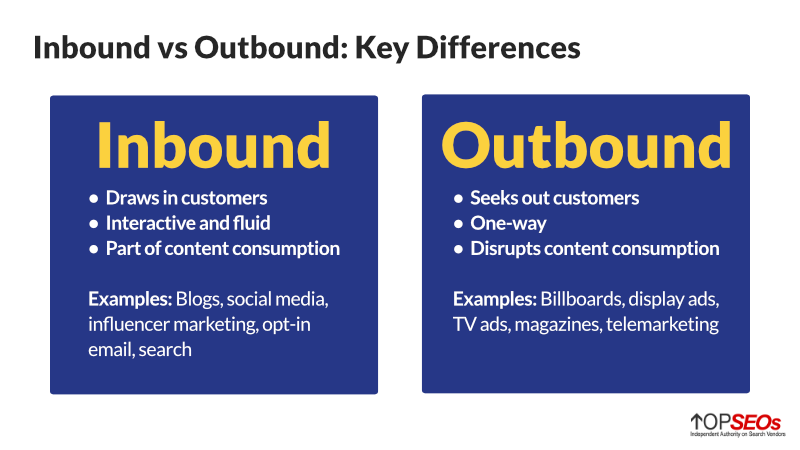
As you can see, inbound marketing and outbound marketing use vary different tactics to get their advertising messages seen.
But are there other differences between the two? Besides the tactics we use for inbound marketing vs outbound marketing, what are those differences?
The difference between these marketing strategies is about preferences at its core.
Consumers have been inundated with outbound, disruptive marketing messages for hundreds of years. They’re tired of it. Consumers don’t want to continue seeing advertising messages that aren’t relevant to them.
Despite its declining popularity, though, outbound marketing can still bring in results. In fact, using inbound and outbound marketing tactics together can get even more from your marketing efforts.
It’s less about which one you’re going to use and more about how you can take the best of both marketing strategies.
Let’s take a closer look at inbound and outbound marketing tactics.
Inbound Marketing Tactics
Inbound marketing tactics are much more modern than outbound strategies. These tactics occur largely on the internet.
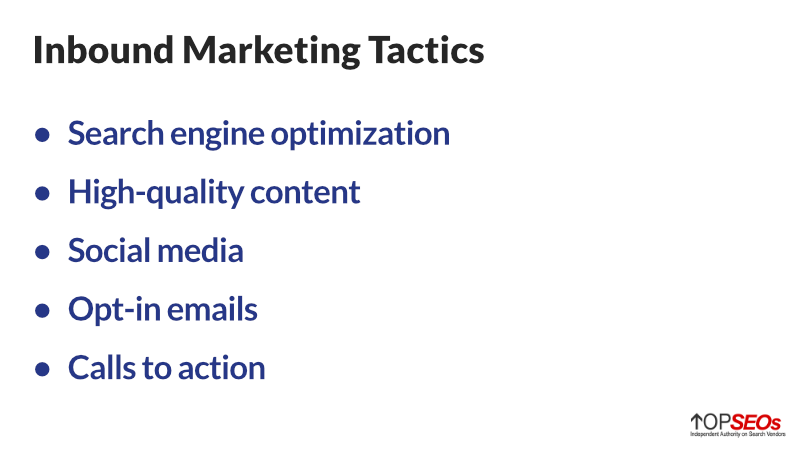
So, what inbound marketing tactics can you use to bring consumers to you?
Search Engine Optimization (SEO)
According to Internetlivestats.com, there are 1.5 billion websites. With all that content, how do you get your message seen by the people who need to see it? Search engine optimization is the best way to get found online.
Search engine optimization is the process of optimizing your website and content to meet the needs of consumers and search engines.
Search engines index and rank pages based on search engine algorithms. These algorithms consider things like keywords, page speed, your site’s authority, and more.
The best thing you can do to get found on search engines, though, is to create in-depth content that thoroughly answers the questions searchers are trying to answer.
High-Quality Content
There used to be a time that you could just shove a bunch of keywords into mediocre content and search engines would gladly rank you higher.
It was a game of keyword density.
These days, however, it’s more important to match searcher intent (what searchers really want when they search certain keywords) and answer searcher’s questions.
Content marketing includes just about everything you produce as a brand: your website, blog posts, ebooks, webinars, infographics, white papers, video, and more. Each piece of content you produce can be optimized in several ways.
Bottom line: if your content isn’t good and useful, you’re simply not going to rank.
Social media
Social media can help you build relationships with consumers and offers you a platform to share content.
This doesn’t include social media ads, though those could be considered an outbound marketing tactic.
Using social media as an inbound tactic means that users are only going to see your content if they want to, or if someone else they follow shares the information you shared.
Social media can be a huge investment in both time and creative production. Since many small businesses don’t have a specific person or team handling their social media, they may not be spending the time needed to get the most out of their social media efforts.
As an inbound marketing tactic, we’re talking about opt-in email marketing.
Opt-in email marketing means that a consumer is receiving your email communications because they subscribed—they gave you permission to market to them.
Email is an effective inbound marketing tactic that can be used to nurture leads, moving them towards the ultimate goal of making a purchase. Its effectiveness increases the further along the customer journey the recipient is.
Calls to Action
A call to action is simply an ask. You’re asking consumers to do something.
This could be something simple like signing up for your newsletter or the ultimate call to action to make a purchase.
The best calls to action are compelling without being salesy. The power is with the consumer to take the action or not.
Outbound Marketing Tactics
Many outbound marketing tactics are dying (or are already dead and buried). These are things like mass-produced marketing materials, yellow pages, TV commercials, and more.
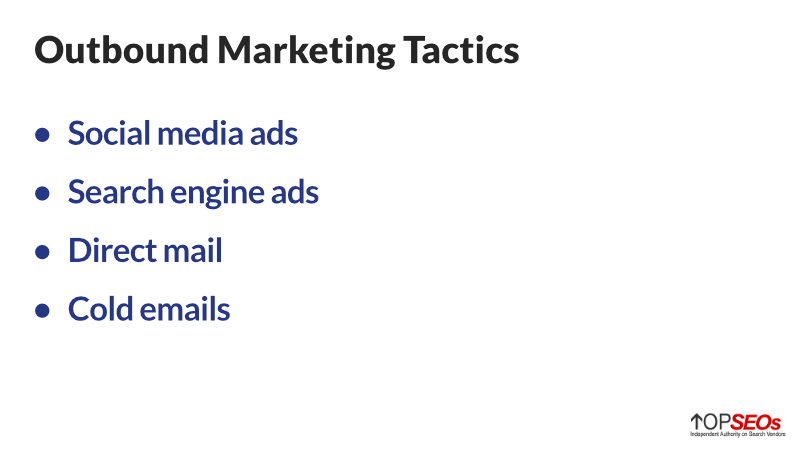
But that still leaves a few outbound marketing tactics that can help you grow your business.
Social Media Ads
Did you know that 49% of the entire world’s population is on social media (Statista)? And, we spend about 2.5 hours on social media every day.
Social media ads are a great way for your company to use outbound marketing tactics to reach consumers where they are.
Search Engine Ads
Similar to social media ads, running search engine ads can put you in front of the right people when they’re searching for what you have to offer.
You could say that these are a hybrid marketing tactic since they only show up for consumers who have actively searched for what you’re offering. They’re not just pushing out to everyone.
Direct Mail
Yes, direct mail still works. In fact, according to the Direct Marketing Association, the response rate for direct mail house lists is 9% while the response rate for prospect lists is 5%.
For retargeting, direct mail performs even better. According to the Data and Marketing Association, direct mail retargeting has a response rate of nearly 25%.
To put that into perspective, digital retargeting click rates are only 0.06%.
This is largely due to how direct mail works. It can be targeted at certain consumer demographics and geographic regions, just like email marketing. But unlike email marketing, direct mail can’t be deleted before the intended recipient sees it.
Since direct mail is physical, the consumer has to see at least some of your messaging as they sort through their mail. Then they have to decide what to do with your marketing piece.
With email marketing, you can easily delete an email without even registering what the subject line said.
Cold Emails
Where email marketing as an inbound tactic means people have opted-in to see marketing emails from you, cold emails (and cold calls) are made to people who have not opted-in and who have no existing relationship with you.
But, wait? Aren’t cold emails spam?
Not according to the CAN-SPAM Act.
As long as you comply with the FTC’s rules, you can absolutely use cold emails as part of your marketing strategy.
Cold outreach can actually be pretty effective since, similar to direct mail, we now have targeting options that are so much better than they were.
Inbound Marketing vs Outbound Marketing: Which to Use
Depending on the tactics you’re using, you could see great success with either inbound or outbound marketing.
Ultimately, it comes down to your business, who you’re trying to reach, and what your goals are.
Here are some things to consider when deciding which marketing tactics to use.
Your Market
Who are your ideal customers? How do they normally shop for the kind of products and services you provide? Where do they go for more information?
To answer these questions, take a closer look at your industry as a whole—and don’t forget to spy on your competitors!—to find out what marketing tactics are most effective.
Your Goals
What are you hoping to achieve with your marketing? Do you want to drive more traffic to your website or boost brand awareness? How many people do you need to reach to hit your goal? How quickly do you want to reach those goals?
If you’re hoping for a quick influx of customers, outbound marketing is going to help you hit that goal. Inbound marketing, on the other hand, is more of a long-term effort.
Of course, inbound marketing also has the most sustainable results while outbound tactics are likely to spike early and drop fast.
Your Brand
How will your marketing tactics impact your brand reputation and image?
This is sometimes a balancing act. Some outbound marketing tactics, like cold emails or cold calls, are effective but don’t exactly give people nice feelings about your brand.
Focus on marketing tactics that you can stand by.
Remember, the most effective marketing strategy will probably include a little bit of both inbound and outbound marketing tactics.
Inbound Marketing vs. Outboard Marketing: Which Is Best?
Inbound marketing and outbound marketing aren’t an either/or. They’re two distinct marketing and advertising approaches that you can use effectively—on their own or together.
As you can tell, each of these strategies has strengths and weaknesses. While outbound marketing can get you results fast, those results tend to come to a close quickly (or get a lot more expensive over time). Inbound marketing, on the other hand, is a better long-term approach.
To get the most from any marketing strategy, it helps to have a digital marketing agency on your side. Check out this list of the best digital marketing agencies you can use to improve your marketing efforts.




















